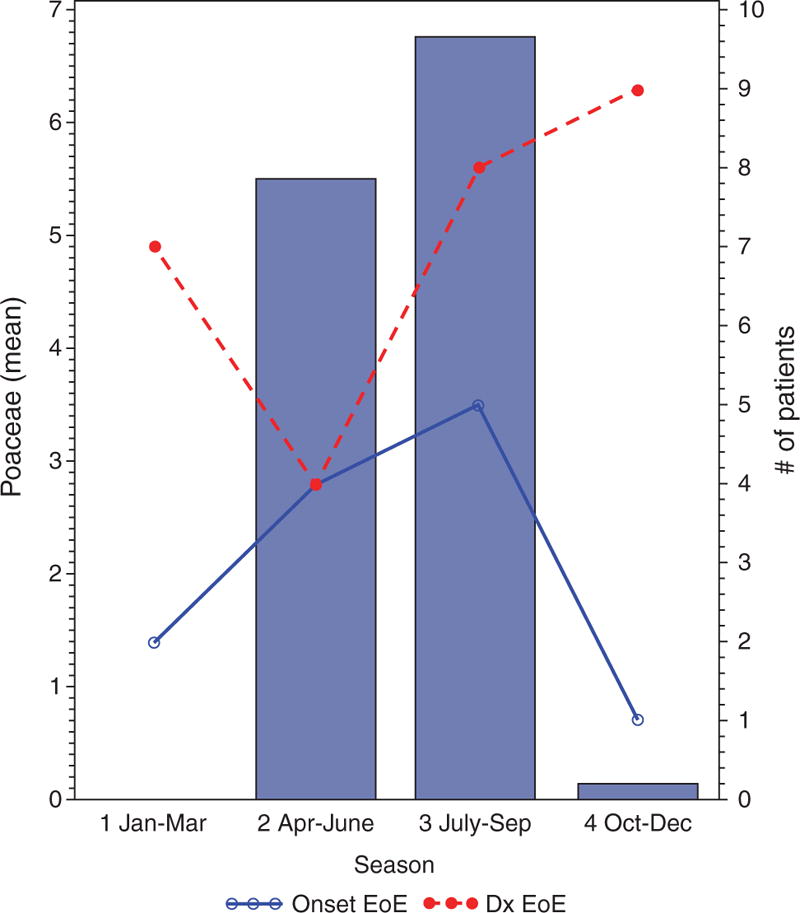Weill Cornell Researchers Find Pediatric EoE Correlation with Seasonal Airborne Allergens
April 6, 2017
In a study published in the Journal of Pediatric Gastroenterology and Nutrition, researchers from the Center for Advanced Digestive Care and the Weill Cornell Department of Pediatrics have identified a seasonal correlation between atmospheric allergen levels and eosinophilic esophagitis symptoms and diagnosis.
The relationship between food allergies and eosinophilic esophagitis (EoE) in pediatric patients is well known in the medical community and documented in research. After an examination of existing medical research on EoE, Dr. Aliza Solomon and her team could only find a limited body of work on the relationship between airborne allergens and the onset of EoE in pediatric patients. A mouse model from Mishra, et al demonstrates EoE can manifest from intranasal exposure to allergens but does so independent of interleukin (IL)-13. One significant study (Moawad, et al) comparing pollen and adult EoE onset over a three-year span is found in the literature. Dr. Solomon set out to answer determine whether a seasonal variation exists in the onset of symptoms or diagnosis of EoE in pediatric patients and if so, whether than variation corresponds with recorded aeroallergen levels in the region studied.
"The original mouse model of EoE introduced by Dr. Mishra and colleagues was developed with an intranasal exposure to Aspergillus fumigatus and sensitization in the respiratory tract via intranasal exposure,” said Dr. Solomon. “Other investigators had also described a potential seasonality to symptoms associated with EoE. It was based on this that we thought that environmental triggers other than foods may be contributing to the development of EoE."

Pollen levels compared to reported onset and reported diagnosis
Specifics of the retrospective study included:
- A chart review of patients ages 0-21 diagnosed with EoE by histologic diagnoses
- A 10-year period of data between 2002 and 2012 was reviewed.
- A total of 38 patients met all criteria for study out of 66 examined.
- Cases were disqualified when records showed eosinophils in other parts of the GI tract, or when no proton pump inhibitor trial was completed, typically used to differentiate between GERD from EoE.
- Atmospheric pollen data came from Fordham University, collected from an elevated spore trap near Lincoln Square in Manhattan. More data was collected from a second pollen station in Westchester County, New York.
Analysis of data gathered in the study showed a seasonal variation in symptom onset and diagnosis of EoE in the patient population:
- The largest number of patients reported symptoms between July and September,
- The largest number of patients were diagnosed between October and December.
- Manhattan pollen data indicated that grass pollen peaked in July-September, while Westchester County data showed ragweed had the highest incidence in the same period.
Dr. Solomon notes that despite the limits of a retrospective study, the correlation described is significant:
“My collaborators study pollen counts in the region, and this was the first time anyone looked at actual counts to correlate the presentation,” notes Dr. Solomon. “Because this was a retrospective chart review, we did not speak to the patients in depth about their symptoms, but used the information already collected in their medical charts to determine when they had reported the start of their symptoms to see if there was a specific pollen that could be associated. This information does not say that this is a cause and effect phenomenon, but it does show that there was an association.”
Dr. Solomon’s research team sees their work as a contribution to the body of work studying aeroallergen incidence and EoE onset, and acknowledges the limited geography and patient sample of their analysis can only provide commentary on the seasonal correlation in the New York City area. Looking ahead, Dr. Solomon sees value in a multi-region, prospective study that covers more pollen types and also fungi if accurate measurement can be obtained.
“I think there is much more work to be done here,” said Dr. Solomon. “We can now prospectively collect information including symptom questionnaires and endoscopic findings to potentially look into the relationship between the disease and aeroallergens.”



